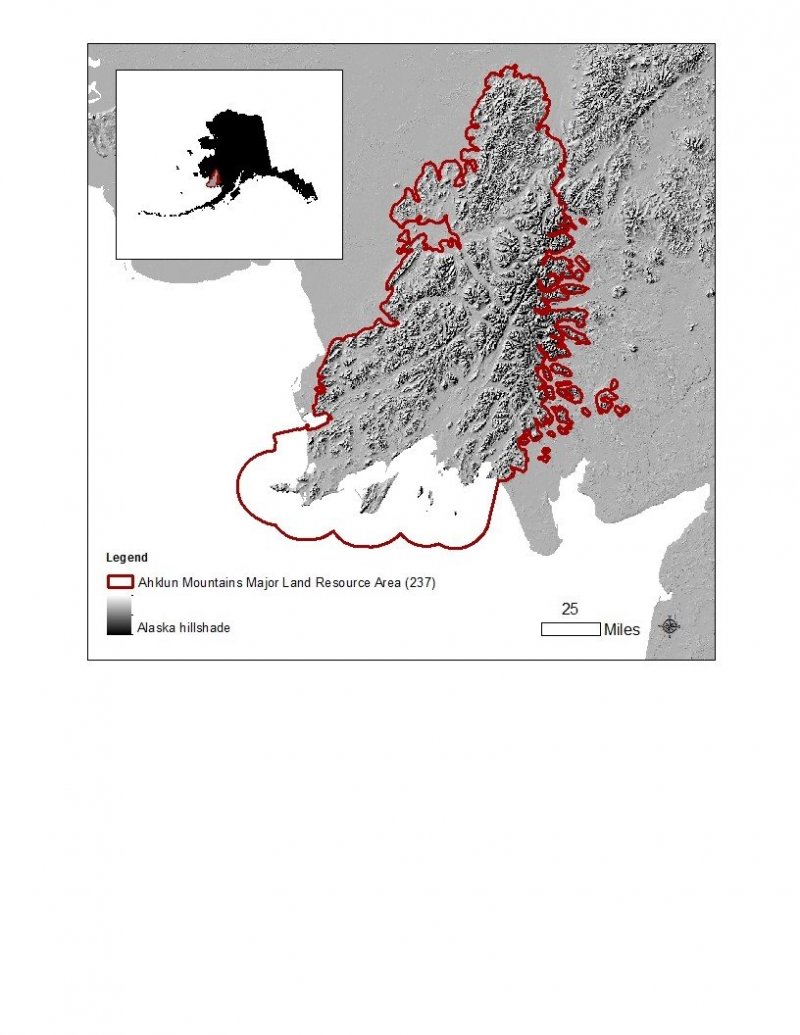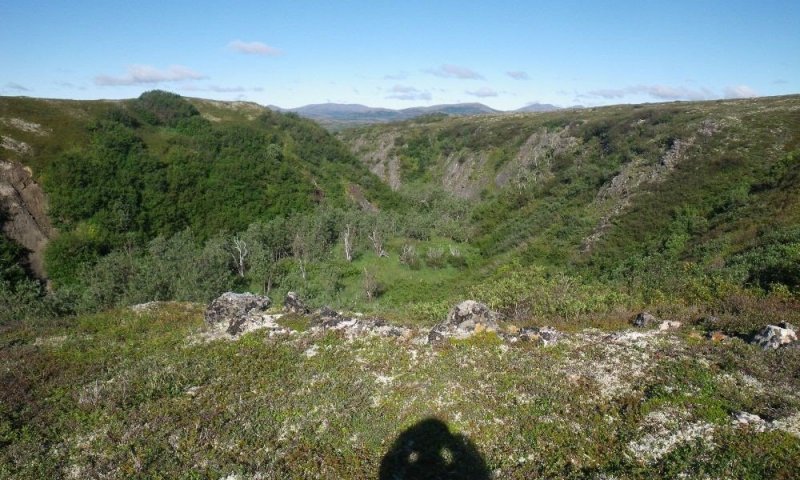

Natural Resources
Conservation Service
Ecological site R237XY203AK
Western Alaska Maritime Scrubland Gravelly Drainage, Escarpment
Last updated: 7/23/2020
Accessed: 12/22/2025
General information
Provisional. A provisional ecological site description has undergone quality control and quality assurance review. It contains a working state and transition model and enough information to identify the ecological site.
MLRA notes
Major Land Resource Area (MLRA): 237X–Ahklun Mountains
The Ahklun Mountains Major Land Resource Area (MLRA 237) is in western Alaska (fig. 3). This MLRA covers approximately 14,555 square miles, and it includes the mountains, hills, and valleys of the Kilbuck Mountains in the north and the Ahklun Mountains in the south. Except for the Kilbuck Mountains and the highest ridges of the Ahklun Mountains, the MLRA was extensively glaciated during the Pleistocene (Kautz et al., 2004). Today, a few small glaciers persist in mountainous cirques (Gallant et al., 1995). The present-day landscape and landforms reflect this glacial history; glacial moraines and glacial drift cover much of the area (USDA-NRCS, 2006). The landscape of the MLRA is primarily defined by low, steep, rugged mountains cut by narrow-to-broad valleys. Flood plains and terraces of varying sizes are common at the lower elevations in the valley bottoms. Glacially carved valleys host many lakes. Togiak Lake is one of the largest lakes in the region. It is 13 miles long and about 9,500 acres in size. Major rivers include the Goodnews, Togiak, Kanektok, Osviak, Eek, and Arolik Rivers. Where the Goodnews and Togiak Rivers reach the coast, the nearly level to rolling deltas support numerous small lakes.
This MLRA has two distinct climatic zones: subarctic continental and maritime continental (fig. 4). The high-elevation areas are in the subarctic continental zone. The mean annual precipitation is more than 75 inches, and the mean annual air temperature is below about 27 degrees F (-3 degrees C) in extreme locations. The warmer, drier areas at the lower elevations are in the maritime continental zone. The mean annual precipitation is 20 to 50 inches, and the mean annual air temperature is about 30 to 32 degrees F (-0.2 to 1.2 degrees C) (PRISM). This climatic zone is influenced by both maritime and continental factors. The temperatures in summer are moderated by the open waters of the Bering Sea, and the temperatures in winter are more continental due to the presence of ice in the sea (Western Regional Climate Center, 2017). The seasonal ice reaches its southernmost extent off the coast of Alaska in Bristol Bay (Alaska Climate Research Center, 2017). The western coast of Alaska is also influenced by high winds from strong storms and airmasses in the Interior Region of Alaska (Hartmann, 2002).
The Ahklun Mountains MLRA is principally undeveloped wilderness. Federally managed lands include the Togiak and Alaska Maritime National Wildlife Refuges. The MLRA is sparsely populated, but it has several communities, including Togiak, Manokotak, Twin Hills, and Goodnews Bay. Togiak is the largest village. It has a population of approximately 855, most of which are Yup’ik Alaska Natives (U.S. Census Bureau, 2016). Major land uses include subsistence activities (fishing, hunting, and gathering) and wildlife recreation (USDA-NRCS, 2006; Kautz et al., 2004).
Ecological site concept
Ecological site R237XY203AK is on steep escarpments throughout the Ahklun Mountains area. These escarpments are on both sides of drainageways that dissect lowland plains. Landform and soil characteristics influence the plant composition and create a unique ecological site. The reference state supports two community phases dictated by erosion processes, including the reference plant community and an early erosion community phase. No alternate states are recorded for this ecological site.
The reference plant community is a closed tall scrubland (Viereck et al., 1992) that consists dominantly of alder (Alnus spp.) and an understory of shade-tolerant forbs and graminoids.
Associated sites
| R237XY208AK |
Western Alaska Maritime Scrubland Peat Depressions Site R237XY203AK is associated with drainageways that dissect lowland plains. Other sites on lowland plains include R237XY208AK, R237XY210AK, R237XY212AK, and R237XY226AK. These sites are on flood plains and shore complexes. They are easily differentiated by one or more criteria, including landform, landform position, associated soils, associated disturbance regimes, and the type and amount of plants. |
|---|---|
| R237XY210AK |
Western Alaska Maritime Scrubland Gravelly Flood Plains Site R237XY203AK is associated with drainageways that dissect lowland plains. Other sites on lowland plains include R237XY208AK, R237XY210AK, R237XY212AK, and R237XY226AK. These sites are on flood plains and shore complexes. They are easily differentiated by one or more criteria, including landform, landform position, associated soils, associated disturbance regimes, and the type and amount of plants. |
| R237XY212AK |
Western Alaska Maritime Scrubland Silty Flood Plains Site R237XY203AK is associated with drainageways that dissect lowland plains. Other sites on lowland plains include R237XY208AK, R237XY210AK, R237XY212AK, and R237XY226AK. These sites are on flood plains and shore complexes. They are easily differentiated by one or more criteria, including landform, landform position, associated soils, associated disturbance regimes, and the type and amount of plants. |
| R237XY226AK |
Western Alaska Maritime Grassland Peat Flood Plains, Depression Site R237XY203AK is associated with drainageways that dissect lowland plains. Other sites on lowland plains include R237XY208AK, R237XY210AK, R237XY212AK, and R237XY226AK. These sites are on flood plains and shore complexes. They are easily differentiated by one or more criteria, including landform, landform position, associated soils, associated disturbance regimes, and the type and amount of plants. |
Similar sites
| R237XY202AK |
Western Alaska Maritime Mosaic Gravelly Slopes Site R237XY202AK supports a community phase of alder, ferns, and bluejoint; however, it is on low-elevation mountains and hills, has a mosaic of two communities, and is not subject to a disturbance regime. Site R237XY203AK supports an early phase associated with erosion. |
|---|---|
| R237XY230AK |
Western Alaska Maritime Scrubland Silty Plains and Mountain Slopes, Lower Site R237XY230AK supports a community similar to that of the reference plant community of site R237XY203AK. Although the reference plant communities are similar, these ecological sites are on different landforms and undergo different disturbances. Site R237XY203AK is subject to erosion, but site R237XY230AK is in areas of wetter soils in swales and a water table is the main driver for the composition of the vegetative community. These differences may result in differences in the overall production of the community, which was not recorded in situ. Separate ecological sites are required because of differences in landform, plant communities, and disturbances. |

Figure 1. The steep escarpments support dense stands of alder and an understory of shade-tolerant forbs and graminoids.

Figure 2. Alder on steep escarpments of a drainageway that bisects a plain.
Table 1. Dominant plant species
| Tree |
Not specified |
|---|---|
| Shrub |
(1) Alnus |
| Herbaceous |
(1) Dryopteris expansa |
Click on box and path labels to scroll to the respective text.
Ecosystem states
State 1 submodel, plant communities
| 1.1A | - | Erosion |
|---|---|---|
| 1.2A | - | Time without disruptive erosion. |





